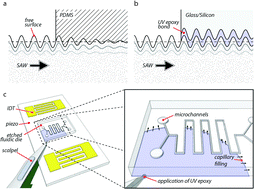UV epoxy bonding for enhanced SAW transmission and microscale acoustofluidic integration†
Abstract
Surface acoustic waves (SAWs) are appealing as a means to manipulate fluids within lab-on-a-chip systems. However, current acoustofluidic devices almost universally rely on elastomeric materials, especially PDMS, that are inherently ill-suited for conveyance of elastic energy due to their strong attenuation properties. Here, we explore the use of a low-viscosity UV epoxy resin for room temperature bonding of lithium niobate (LiNbO3), the most widely used anisotropic piezoelectric substrate used in the generation of SAWs, to standard micromachined superstrates such as Pyrex® and silicon. The bonding methodology is straightforward and allows for reliable production of sub-micron bonds that are capable of enduring the high surface strains and accelerations needed for conveyance of SAWs. Devices prepared with this approach display as much as two orders of magnitude, or 20 dB, improvement in SAW transmission compared to those fabricated using the standard PDMS elastomer. This enhancement enables a broad range of applications in acoustofluidics that are consistent with the low power requirements of portable battery-driven circuits and the development of genuinely portable lab-on-a-chip devices. The method is exemplified in the fabrication of a closed-loop bidirectional SAW pumping concept with applications in micro-scale flow control, and represents the first demonstration of closed channel SAW pumping in a bonded glass/LiNbO3 device.


 Please wait while we load your content...
Please wait while we load your content...